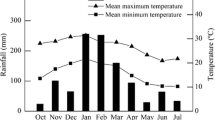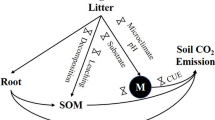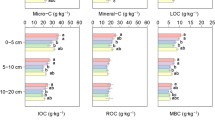Abstract
Purpose
The quantity and quality of litter inputs to forest soils are likely to be changed as a result of the climate change and human disturbances. However, the effects of changed litter inputs on soil labile carbon (C) and nitrogen (N) pools still remain unclear.
Materials and methods
A 15-month in situ field experiment was conducted within both high and low litter quality site in a eucalyptus-dominated native forest of Queensland, Australia. Three rates of litter inputs were applied, including (i) no litter (NL); (ii) single litter (SL), representing the average condition of the surrounding forest floor; and (iii) double litter (DL). Water-extractable organic C (WEOC) and total N (WETN), hot water-extractable organic C (HWEOC) and total N (HWETN), microbial biomass C (MBC), and N (MBN) were analyzed in the 0–5-cm soil layer seasonally.
Results and discussion
Litter input rates had no significant effects on litter decomposition at both sites (P > 0.05). After 15-month of decomposition, mean litter mass loss was 46.3% and 31.2% at the HQ and LQ sites, respectively. Changed litter quantity had no significant effects on any of the soil labile C and N pools, regardless of litter quality. However, soil labile C and N pools significantly varied with sampling times, and the samples of different sampling times were clearly separated at both sites according to the redundancy analysis (RDA). WEOC peaked in summer, declined in autumn and winter, and increased again in spring, while the concentrations of HWEOC and MBC peaked in the winter period. The seasonal trends of MBN were opposite to the trends of WETN, which might be due to the temporal partitioning of N between plants and microbes.
Conclusions
The findings indicated that soil labile C and N pools in the eucalyptus-dominated forest of subtropical Australia were resistant to a short-term change in aboveground litter inputs. Future research should expand on these findings by keeping observing over a longer time period and considering the influence of changed belowground litter inputs.




Similar content being viewed by others
References
Bai SH, Blumfield TJ, Reverchon F (2014) The impact of mulch type on soil organic carbon and nitrogen pools in a sloping site. Biol Fertil Soils 50:37–44
Benesch M, Glaser B, Dippold M, Zech W (2015) Soil microbial C and N turnover under Cupressus lusitanica and natural forests in southern Ethiopia assessed by decomposition of 13C- and 15N-labelled litter under field conditions. Plant Soil 388:133–146
Blumfield TJ, Xu ZH, Mathers NJ, Saffigna PG (2004) Decomposition of nitrogen-15 labeled hoop pine harvest residues in subtropical Australia. Soil Sci Soc Am J 68:1751–1761
Brookes PC, Landman A, Pruden G, Jenkinson DS (1985) Chloroform fumigation and the release of soil nitrogen: a rapid direct extraction method to measure microbial biomass nitrogen in soil. Soil Biol Biochem 17:837–842
Bu X, Gu X, Zhou X, Zhang M, Guo Z, Zhang J, Zhou X, Chen X, Wang X (2018) Extreme drought slightly decreased soil labile organic C and N contents and altered microbial community structure in a subtropical evergreen forest. Forest Ecol Manag 429:18–27
Catterall CP, Wallace CJ (1987) An island in suburbia: the natural and social history of Toohey Forest. Institute of Applied Environmental Research, Griffith University, Brisbane
Cepáková S, Tošner Z, Frouz J (2016) The effect of tree species on seasonal fluctuations in water-soluble and hot water-extractable organic matter at post-mining sites. Geoderma 275:19–27
Che RX, Qin JL, Tahmasbian I, Wang F, Zhou ST, Xu ZH, Cui XY (2018) Litter amendment rather than phosphorus can dramatically change inorganic nitrogen pools in a degraded grassland soil by affecting nitrogen-cycling microbes. Soil Biol Biochem 120:145–152
Chen CR, Xu ZH (2005) Soil carbon and nitrogen pools and microbial properties in a 6-year-old slash pine plantation of subtropical Australia: impacts of harvest residue management. Forest Ecol Manag 206:237–247
Chen CR, Xu ZH, Blumfield TJ, Hughes JM (2003) Soil microbial biomass during the early establishment of hoop pine plantation: seasonal variation and impacts of site preparation. Forest Ecol Manag 186:213–225
Cotrufo ME, Miller M, Zeller B (2000) Litter decomposition. In: Schulze ED (eds) Carbon and nitrogen cycling in European forest ecosystems. Springer, Berlin, pp 276–296
Ellsworth DS, Thomas R, Crous KY, Palmroth S, Ward E, Maier C, DeLucia E, Oren R (2012) Elevated CO2 affects photosynthetic responses in canopy pine and subcanopy deciduous trees over 10 years: a synthesis from Duke FACE. Glob Chang Biol 18:223–242
Fang X, Zhao L, Zhou GY, Huang WJ, Liu JX (2015) Increased litter input increases litter decomposition and soil respiration but has minor effects on soil organic carbon in subtropical forests. Plant Soil 392:139–153
Fisk M, Fahey T (2001) Microbial biomass and nitrogen cycling responses to fertilization and litter removal in young northern hardwood forests. Biogeochemistry 53:201–223
Ghani A, Dexter M, Perrott KW (2003) Hot-water extractable carbon in soils: a sensitive measurement for determining impacts of fertilisation, grazing and cultivation. Soil Biol Biochem 35:1231–1243
Gould JS, McCaw WL, Cheney NP (2011) Quantifying fine fuel dynamics and structure in dry eucalypt forest (Eucalyptus marginata) in Western Australia for fire management. Forest Ecol Manag 262:531–546
Guinto DF, Xu ZH, House APN, Saffigna PG (2001) Soil chemical properties and forest floor nutrients under repeated prescribed burning in eucalypt forests of south-east Queensland, Australia. NZ J For Sci 31:170–187
Hamkalo Z, Bedernichek T (2014) Total, cold and hot water extractable organic carbon in soil profile: impact of land-use change. Zemdirbyste-Agriculture 101:125–132
Hättenschwiler S, Tiunov AV, Scheu S (2005) Biodiversity and litter decomposition in terrestrial ecosystems. Annu Rev Ecol Evol Syst 36:191–218
Hu ZH, He ZM, Huang ZQ, Fan SH, Yu ZP, Wang MH, Zhou XH, Fang CM (2014) Effects of harvest residue management on soil carbon and nitrogen processes in a Chinese fir plantation. Forest Ecol Manag 326:163–170
Joly FX, Fromin N, Kiikkilä O, Hättenschwiler S (2016) Diversity of leaf litter leachates from temperate forest trees and its consequences for soil microbial activity. Biogeochemistry 129:373–388
Kaiser C, Fuchslueger L, Koranda M, Gorfer M, Stange CF, Kitzler B, Rasche F, Strauss J, Sessitsch A, Zechmeister-Boltenstern S, Richter A (2011) Plants control the seasonal dynamics of microbial N cycling in a beech forest soil by belowground C allocation. Ecology 92:1036–1051
Kalbitz K, Schwesig D, Rethemeyer J, Matzner E (2005) Stabilization of dissolved organic matter by sorption to the mineral soil. Soil Biol Biochem 37:1319–1331
Lajtha K, Bowden RD, Crow S, Fekete I, Kotroczo Z, Plante AF, Simpson MJ, Nadelhoffer KJ (2018) The detrital input and removal treatment (DIRT) network: insights into soil carbon stabilization. Sci Total Environ 640:1112–1120
Leff JW, Wieder WR, Taylor PG, Townsend AR, Nemergut DR, Grandy AS, Cleveland CC (2012) Experimental litterfall manipulation drives large and rapid changes in soil carbon cycling in a wet tropical forest. Glob Chang Biol 18:2969–2979
Melillo JM, Aber JD, Muratore JF (1982) Nitrogen and lignin control of hardwood leaf litter decomposition dynamics. Ecology 63:621–626
Muqaddas B, Lewis T, Esfandbod M, Chen C (2019) Responses of labile soil organic carbon and nitrogen pools to long-term prescribed burning regimes in a wet sclerophyll forest of southeast Queensland, Australia. Sci Total Environ 647:110–120
Olson JS (1963) Energy storage and the balance of producers and decomposers in ecological systems. Ecology 44:322–331
Potila H, Sarjala T (2004) Seasonal fluctuation in microbial biomass and activity along a natural nitrogen gradient in a drained peatland. Soil Biol Biochem 36:1047–1055
Putuhena WM, Cordery I (1996) Estimation of interception capacity of the forest floor. J Hydrol 18:283–299
Raich JW, Russell AE, Kitayama K, Parton WJ, Vitousek PM (2006) Temperature influences carbon accumulation in moist tropical forests. Ecology 87:76–87
Sayer EJ (2006) Using experimental manipulation to assess the roles of leaf litter in the functioning of forest ecosystems. Biol Rev 81:1–31
Sayer EJ, Tanner EVJ (2010) Experimental investigation of the importance of litterfall in lowland semi-evergreen tropical forest nutrient cycling. J Ecol 98:1052–1062
Schadt CW, Martin AP, Lipson DA, Schmidt SK (2003) Seasonal dynamics of previously unknown fungal lineages in tundra soils. Science 301:1359–1361
Schmidt SK, Costello EK, Nemergut DR, Cleveland CC, Reed SC, Weintraub MN, Meyer AF, Martin AM (2007) Biogeochemical consequences of rapid microbial turnover and seasonal succession in soil. Ecology 88:1379–1385
Sparling G, Vojvodic-Vukovic M, Schipper LA (1998) Hot-water-soluble C as a simple measure of labile soil organic matter: the relationship with microbial biomass C. Soil Biol Biochem 30:1469–1472
Thomas BW, Whalen JK, Sharifi M, Chantigny M, Zebarth BJ (2016) Labile organic matter fractions as early-season nitrogen supply indicators in manure-amended soils. J Plant Nutr Soil Sci 179:94–103
Toberman H, Chen C, Lewis T, Elser JJ (2014) High frequency fire alters C:N:P stoichiometry in forest litter. Glob Chang Biol 20:2321–2331
Uchida Y, Nishimura S, Akiyama H (2012) The relationship of water-soluble carbon and hot-water-soluble carbon with soil respiration in agricultural fields. Agric Ecosyst Environ 156:116–122
van Diepen LTA, Frey SD, Sthultz CM, Morrison EW, Minocha R, Pringle A (2015) Changes in litter quality caused by simulated nitrogen deposition reinforce the N-induced suppression of litter decay. Ecosphere 6:1–15
Vance ED, Brookes PC, Jenkinson DS (1987) An extraction method for measuring soil microbial biomass C. Soil Biol Biochem 19:703–707
Wang YZ, Xu ZH, Zheng JQ, Abdullah KM, Zhou QX (2015) δ15N of soil nitrogen pools and their dynamics under decomposing leaf litters in a suburban native forest subject to repeated prescribed burning in southeast Queensland, Australia. J Soils Sediments 15:1063–1074
Wardle DA, Hornberg G, Zackrisson O, Kalela-Brundin M, Coomes DA (2003) Long-term effects of wildfire on ecosystem properties across an island area gradient. Science 300:972–975
Wardle DA, Bardgett RD, Klironomos JN, Setala H, van der Putten WH, Wall DH (2004) Ecological linkages between aboveground and belowground biota. Science 304:1629–1633
Williams MC, Wardle GM (2007) Pine and eucalypt litterfall in a pine-invaded eucalypt woodland: the role of fire and canopy cover. Forest Ecol Manag 253:1–10
Wood TE, Lawrence D (2008) No short-term change in soil properties following four-fold litter addition in a Costa Rican rain forest. Plant Soil 307:113–122
Wu J, Zhang D, Chen Q, Feng J, Li Q, Yang F, Zhang Q, Cheng X (2018) Shifts in soil organic carbon dynamics under detritus input manipulations in a coniferous forest ecosystem in subtropical China. Soil Biol Biochem 126:1–10
Xu ZH, Saffigna PG, Myers RJK, Chapman AL (1993) Nitrogen cycling in leucaena (Leucaena leucocephala) alley crop ping in semi-arid tropics. I. Mineralization of nitrogen from leucaena residues. Plant Soil 148:63–72
Xu S, Liu LL, Sayer EJ (2013) Variability of above-ground litter inputs alters soil physicochemical and biological processes: a meta-analysis of litterfall-manipulation experiments. Biogeosciences 10:7423–7433
Zhao M, Running SW (2010) Drought-induced reduction in global terrestrial net primary production from 2000 through 2009. Science 329:940–943
Zhao Q, Classen AT, Wang WW, Zhao XR, Mao B, Zeng DH (2017) Asymmetric effects of litter removal and litter addition on the structure and function of soil microbial communities in a managed pine forest. Plant Soil 414:81–93
Zhou X, Guo Z, Chen C, Jia Z (2017) Soil microbial community structure and diversity are largely influenced by soil pH and nutrient quality in 78-year-old tree plantations. Biogeosciences 14:2101–2111
Acknowledgements
We are grateful to Geoffery Lambert, Yan Xu, Vaeno Vigulu, Ming Zhong, and Yan Zhao for the field assistance, as well as Geoffrey Lambert, Rene Diocares, Radoslaw Bak, and Marijke Heenan for their help in laboratory analyses.
Author information
Authors and Affiliations
Corresponding author
Additional information
Responsible editor: Hailong Wang
Publisher’s note
Springer Nature remains neutral with regard to jurisdictional claims in published maps and institutional affiliations.
Electronic supplementary material
ESM 1
(DOCX 20 kb)
Rights and permissions
About this article
Cite this article
Wang, Y., Zheng, J., Xu, Z. et al. Effects of changed litter inputs on soil labile carbon and nitrogen pools in a eucalyptus-dominated forest of southeast Queensland, Australia. J Soils Sediments 19, 1661–1671 (2019). https://doi.org/10.1007/s11368-019-02268-9
Received:
Accepted:
Published:
Issue Date:
DOI: https://doi.org/10.1007/s11368-019-02268-9




